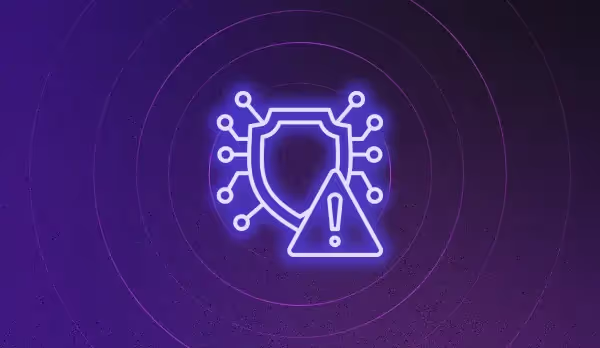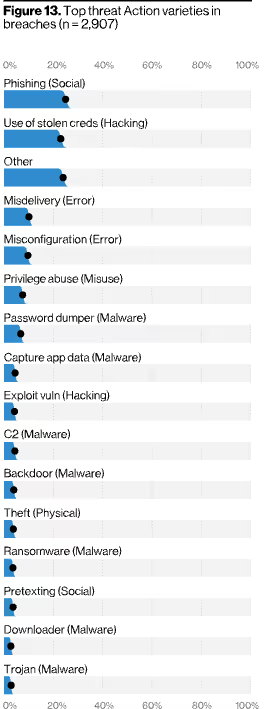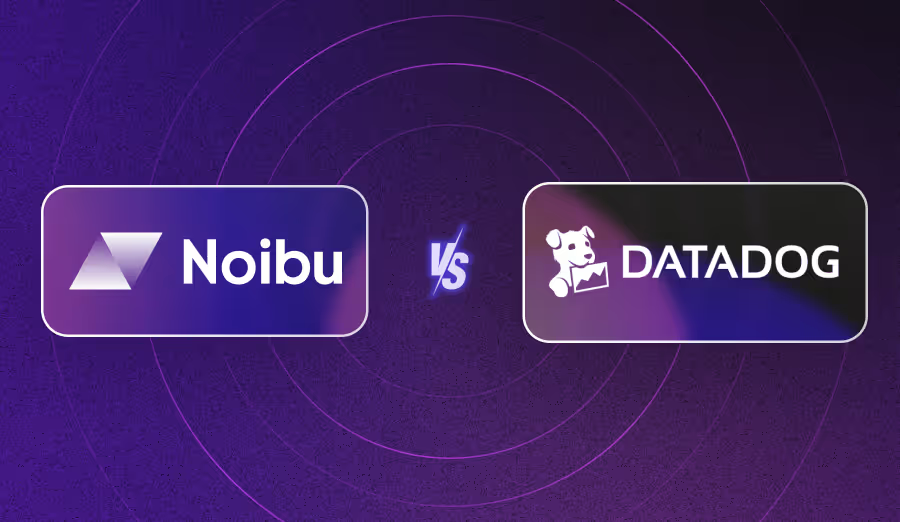What are the biggest security threats to every ecommerce business?

In today's digital era, ecommerce has become an essential part of the growth strategy for many businesses. However, with the rise of ecommerce, security threats to ecommerce websites have also increased significantly. As a matter of fact, the ecommerce industry is the most vulnerable of all, accounting for 32.4% of all cyber attacks.
Cybercriminals target ecommerce websites with the intention of stealing sensitive customer data, personal information, and financial details. This is why it is crucial for every ecommerce business to have proper security measures in place to prevent these security threats.
In this article, you can learn about the most common ecommerce security threats and the best tactics to make your ecommerce website unbreachable.
Why is ecommerce security important?
- Ecommerce businesses handle sensitive customer data, including personal information, credit card numbers, and financial details. Any security breach in an ecommerce website can result in the loss of this sensitive data, leading to financial losses both for the customers and the business.
- Security for ecommerce websites is important to maintain the trust and loyalty of customers. In case an online business suffers a security breach, customers may lose trust in the business, leading to a loss of reputation and credibility.
- Ecommerce organizations are legally required to protect their customer's sensitive data. Non-compliance with data protection laws can lead to severe legal consequences and penalties.
11 types of security threats in ecommerce
ecommerce
websites face various security threats, so it’s essential for businesses to understand these cyber threats in order to implement appropriate security measures. What follows is a list of some of the most common security threats in ecommerce.
Phishing and social engineering attacks
Phishing is a cyber attack where cybercriminals trick victims into giving away sensitive information, such as usernames, passwords, and credit card numbers. According to Verizon’s DBIR report, more than 20% of data breaches in 2020 were a result of phishing attacks.

Cybercriminals often use social engineering tactics, such as creating fake emails, websites, or social media profiles, to lure victims into providing this information. Phishing attacks can be very extremely convincing, so it's important to educate ecommerce website users on how to identify phishing attempts.
Malware
Malware refers to malicious software that cybercriminals use to gain unauthorized access to an ecommerce website. It can include viruses, worms, Trojans, and ransomware.
A malware attack can infect ecommerce websites through various means, including email attachments, malicious downloads, and infected advertisements. This type of attack can cause significant damage to ecommerce websites, resulting in the loss of customer data, business reputation, and financial losses.
DDoS attacks
In distributed denial of service (DDoS) attacks, cybercriminals flood an ecommerce website's server with malicious traffic, causing the website to crash or become unavailable. These malicious attacks can cause significant financial losses for ecommerce businesses as they prevent customers from accessing the website and making purchases.
SQL injection
SQL injection attack is a cyber attack where cybercriminals inject malicious code into an ecommerce website's SQL database, allowing them to access sensitive data such as customer information, financial data, and personal data. They can cause significant damage to an ecommerce website, resulting in the loss of customer data and business reputation.
Zero-day exploit
A zero-day exploit is a security vulnerability that is unknown to software vendors or developers. Cybercriminals can use zero-day exploits to gain unauthorized access to an ecommerce website and steal sensitive data, such as customer information, credit card details, and other confidential data.
E-skimming
E-skimming is a type of cyber attack where hackers install malicious code into an ecommerce website's payment page. The malicious code can steal customers' payment card details, including card numbers, CVV codes, and expiry dates, as customers enter their payment information.
Man-in-the-Middle (MITM) attackE
In a man-in-the-middle attack, the perpetrator gets ahold of communication between two parties (such as a customer and an ecommerce website) to steal sensitive information, such as credit card details. MITM attacks can occur when an attacker gains access to an unsecured Wi-Fi network or through phishing emails.
Cross-Site Scripting (XSS)
This is a type of attack where hackers inject malicious code into a vulnerable ecommerce website, which can be executed by users who visit the site. This attack allows the attacker to steal sensitive customer data, such as login credentials, payment card details, and other confidential information.
Insider threats
An insider threat is a security threat that arises from within the ecommerce business itself, such as employees or contractors. Insiders can use their privileged access to steal sensitive data or cause damage to the ecommerce website or the business.
User error
User error can also lead to security breaches in an ecommerce website. Common user errors include weak passwords, sharing login credentials, and falling for phishing emails.
Brute force attacks
A brute force attack is a type of cyber attack where an attacker attempts to gain access to an ecommerce website by guessing login credentials through trial and error. Brute force attacks can be successful if the website has weak passwords or doesn’t have a system in place to prevent multiple login attempts.
19 ecommerce security best practices and solutions
To ensure ecommerce security, businesses need to adopt various best practices which help to prevent security breaches, protect sensitive data, and maintain customer trust.
Use SSL certificates
This is one of the most effective ways to secure an ecommerce website. SSL certificates encrypt the data that is transmitted between the ecommerce website and the customer's browser, ensuring that sensitive data is protected from cybercriminals.
- Obtain and install an SSL/TLS certificate from a trusted Certificate Authority (CA).
- Configure the certificate to use strong encryption, such as 256-bit encryption.
Implement multi-factor authentication
Multi-factor authentication is a security measure that requires users to provide two or more forms of identification before accessing an ecommerce website. This can prevent unauthorized access to an ecommerce website, stopping cybercriminals from stealing sensitive data.
- Enable multi-factor authentication for all user accounts.
- Use a combination of authentication factors, such as a password and a one-time code sent via SMS or email.
- Regularly review and update authentication factors as necessary.
Regularly update software
Ecommerce websites use various specialized software, including content management systems, shopping carts, and payment gateways. Regularly updating this software is crucial to prevent security vulnerabilities that cybercriminals can exploit.
- Regularly update all ecommerce software, including plugins and themes.
- Enable automatic updates where possible.
- Test updates in a staging environment before deploying to the live ecommerce website.
Conduct regular security audits
Regularly conducting security audits is essential to identify security vulnerabilities in an ecommerce website. Security audits can point out potential threats, allowing businesses to take preventive measures to protect their ecommerce website from cybercriminals.
- Use automated tools and manual testing to identify vulnerabilities.
- Address vulnerabilities promptly and thoroughly.
Use strong passwords
This is an essential ecommerce security best practice. As you probably already know, each user should have a unique, strong, and complex password, and they should include a combination of uppercase and lowercase letters, numbers, and special characters.
- Passwords should be changed regularly and users should be encouraged to use a password manager to store their passwords securely.
- Require strong passwords for all user accounts.
- Use a password policy that includes minimum length, complexity, and expiration requirements.
- Do not share passwords across different websites or use easily guessable admin names.
Implement least-privilege access
Least-privilege access is a security principle that ensures users only have access to the data and resources they need to perform their job functions. Implementing least-privilege access can prevent unauthorized access to sensitive data, reducing security risks. That’s one of the security principles we follow in Noibu to secure our clients’ data.
- Use a least-privilege access model for user accounts to limit access to sensitive areas of the ecommerce website to authorized personnel only.
- Regularly review and update user permissions as necessary.
Educate employees
Did you know that as much as 95% of cybersecurity breaches are a result of human error? This generally happens due to poor password management, inconsistent cyber hygiene practices, and a lack of continuous cybersecurity awareness training.
This is precisely why educating employees on ecommerce security best practices is essential if your goal is to prevent security breaches.
Employees should be trained on how to identify phishing attempts, create strong passwords, as well as use two-factor authentication. They should also be informed about the importance of keeping software up-to-date and how to identify potential security threats.
- Develop and communicate a security policy for your ecommerce business that outlines security best practices and expectations for employees.
- Conduct security training sessions for all employees to educate them about ecommerce security risks and threats, and how to prevent them.
- Encourage employees to use strong passwords for all accounts, including personal accounts.
But educate your customers too
Educating your employees is just half of the equation. You should inform your customers about how to identify phishing attempts and they should also know about the importance of identifying potential online threats.
- Create an ecommerce security guide or tutorial for customers.
- Send periodic newsletters or alerts to customers to keep them informed about the latest security threats.
- Encourage customers to use strong passwords, enable two-factor authentication, and keep software up-to-date.
- Provide clear and concise instructions for reporting security incidents or suspected security incidents.
- Teach them to never disclose personal information unless they have confirmed the recipient's identity.
- Moreover, they should avoid clicking on links in suspicious emails, as these links may lead them to a fake login page designed to steal their data. Also, warn them against downloading any unexpected attachments.
- They need to watch out for spelling and grammatical errors in the email's subject line or body. Encourage them to pay close attention to the sender's domain name, as phishing emails often use domains that are similar to legitimate ones but with minor changes, such as a misspelling or a letter missing.
- Finally, they should be cautious of emails that urge them to transfer money or approve a charge immediately and provide a reason why it must be done right away. These are common tactics used by scammers to exploit urgency and make people act without thinking.
Regularly back up data
Regularly backing up data is essential in case of a security breach or data loss. Online businesses should ensure that they have a backup plan in place as well as that backups are stored securely and off-site.
- Regularly back up all ecommerce data, including customer information and transaction data.
- Use a backup system that is separate from the live ecommerce website.
- Test backups regularly to ensure they are complete and accurate.
Use HTTPS
HTTPS encrypts the data transmitted between a website and a user's browser, making it difficult for hackers to intercept or steal data. Using HTTPS also helps to prevent man-in-the-middle (MITM) attacks and protects customers' sensitive data.
- Obtain and install an SSL/TLS certificate from a trusted Certificate Authority (CA).
- Enable HTTPS on all pages of the ecommerce website, including checkout and payment pages.
- Use HTTP Strict Transport Security (HSTS) to ensure that all communication is encrypted.
Install ecommerce security plugins
These plugins provide additional security features, such as two-factor authentication, login attempts monitoring, and malware scanning. By using ecommerce security plugins, businesses can enhance their website security and protect customer data.
Moreover, if you want to keep your website healthy, think about using some of these ecommerce platforms and tools. They can help you with various aspects of ecommerce, including research, marketing, automation, and more.
- Research and install a reputable ecommerce security plugin that meets your business needs.
- Configure the plugin to monitor login attempts, scan for malware, and enable two-factor authentication.
- Regularly update the plugin to ensure it is up-to-date with the latest security features.
Use firewalls
Firewalls are essential for protecting an ecommerce website from unauthorized access. A firewall acts as a barrier between the ecommerce website and the internet, blocking unauthorized access attempts.
- Research and install a reputable firewall that meets your business needs.
- Configure the firewall to block unauthorized access attempts and protect sensitive data.
- Regularly update the firewall to ensure it is up-to-date with the latest security standards.
Multilayer security
This approach involves using more than one layer of security to protect the website from various types of security threats.
- Use a combination of firewalls, antivirus software, and intrusion detection systems.
- Regularly scan for malware and viruses using antivirus software.
Don’t forget payment gateway security
Payment gateway security is crucial to ensure the security of online transactions. This way, you can protect customers' payment card details and prevent fraudulent transactions.
- Use a secure payment gateway that complies with Payment Card Industry Data Security Standards (PCI DSS).
- Use tokenization to replace sensitive data with a non-sensitive placeholder.
- Implement fraud detection and prevention measures, such as address verification and velocity checks.
Secure servers and admin panels
To prevent unauthorized access to the ecommerce website, you should use strong passwords, restrict access to servers and admin panels, and regularly update software to prevent security breaches.
- Ensure that your server is properly secured by using strong passwords and disabling any unnecessary services.
- Only allow trusted IP addresses to connect.
- Regularly update your server software to ensure that known security vulnerabilities are patched.
- Limit access to your admin panel by only allowing authorized personnel to log in.
- Use strong passwords and two-factor authentication to prevent unauthorized access.
- Implement a lockout policy that locks out users after a certain number of failed login attempts.
Install anti-virus and anti-malware software
If you want to protect your ecommerce website from malware and viruses, anti-malware and anti-virus software are the way to go. They scan the website for malware and viruses and remove them to prevent security breaches.
- Choose a reputable antivirus and anti-malware software that meets your business needs.
- Configure the software to regularly scan for malware and viruses.
- Regularly update the software to ensure it can block the latest and most advanced viruses and malware.
Use closed-source code
Finally, closed-source code is code that is not publicly available, making it difficult for hackers to identify vulnerabilities. Instead of using open-source code, focus on closed-source code to enhance website security and prevent security breaches.
- Use closed source code for critical areas of the ecommerce website, such as the checkout and payment pages.
- Regularly audit the code for vulnerabilities and apply security patches as necessary.
- Consider using a code signing certificate to ensure the integrity of the code.
Keep only essential customer data
When it comes to data storage, the key principle is to avoid holding onto more data than necessary for conducting your business efficiently. However, determining what qualifies as necessary involves a multitude of factors.
Especially with the emergence of various data privacy regulations, it's crucial to establish a comprehensive business philosophy that considers customer experience, operational convenience, and security.
You should ensure that your customers' vital data is kept separate from other information by segmenting your network. With that in mind, consider employing firewalls and conducting regular audits to verify the proper functioning of your security measures.
Enhance your website security during the holiday season
The holiday season often sees a surge in attempted cybercrime and fraudulent activity, with the increased traffic and pressure creating opportunities for attackers. To safeguard your website's security during this time, consider the following measures:
Conduct a pre-holiday security check
Most ecommerce cyber-attacks occur during the holiday season when retailers are busy and often unprepared. Conduct a comprehensive security check before the season begins, including point-of-sale system malware checks and improved web server security.
Also, review and manage access to your store's admin-level accounts and permissions for all your tools and software.
Heighten your fraud protection
Increased shopping volume can lead to more fraudulent activities. Chargeback scams are a prevalent form of cyber risk for ecommerce brands, making it essential to acquire effective fraud protection tools.
Train your customer service team
Train your team to handle common threats and establish a clear process for verifying customer identity when they request changes to their orders or accounts. This can help you avoid unauthorized access or fraudulent account activities.
Final thoughts
Ecommerce security threats are evolving and becoming more sophisticated, which means that businesses must implement a variety of security measures to protect their ecommerce sites from cybercriminals and fraudulent activities.
The tactics listed in this article are some of the best ecommerce security practices that businesses can adopt to enhance their security posture and prevent security issues. By implementing these security measures, you can ensure that your customers' sensitive data is protected and that their business reputation and credibility remain intact.
In Noibu, we think is one of the most important aspects of every ecommerce business. If you want to find out more about our product, take a look at the eight challenges Noibu solves.



.avif)
